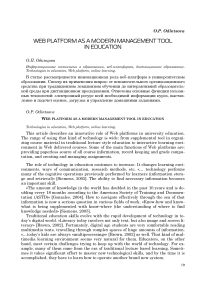Веб-платформа как инструмент современного менеджмента в образовании
Автор: Одинцова Оксана Петровна
Журнал: Вестник Красноярского государственного педагогического университета им. В.П. Астафьева @vestnik-kspu
Рубрика: Научно-образовательный форум
Статья в выпуске: 4 (22), 2012 года.
Бесплатный доступ
В статье рассматривается инновационная роль веб-платформ в университетском образовании. Спектр их применения широк: от вспомогательного организационного средства при традиционном лекционном обучении до интерактивной образовательной среды при дистанционном преподавании. Отмечены основные функции указанных технологий: электронный ресурс всей необходимой информации курса, выставление и подсчет оценок, загрузка и управление домашними заданиями.
Информационные технологии в образовании, веб-платформа, дистанционное образование
Короткий адрес: https://sciup.org/144153591
IDR: 144153591
Текст статьи Веб-платформа как инструмент современного менеджмента в образовании
В статье рассматривается инновационная роль веб-платформ в университетском образовании. Спектр их применения широк: от вспомогательного организационного средства при традиционном лекционном обучении до интерактивной образовательной среды при дистанционном преподавании. Отмечены основные функции указанных технологий: электронный ресурс всей необходимой информации курса, выставление и подсчет оценок, загрузка и управление домашними заданиями.
O.P. Odintsova
W eb platform as a modern management tool in education
Technologies in education, Web platform, online learning.
This article describes an innovative role of Web platforms in university education. The range of using that kind of technology is wide: from supplemental tool in organizing course material in traditional lecture style education to interactive learning environment in Web delivered courses. Some of the main functions of Web platforms are: providing paperless source of all course information, record keeping and grade computation, and creating and managing assignments.
The role of technology in education continues to increase. It changes learning environments, ways of communication, research methods, etc. «… technology performs many of the cognitive operations previously performed by learners (information storage and retrieval)» [Siemens, 2005]. The ability to find necessary information becomes an important skill.
«The amount of knowledge in the world has doubled in the past 10 years and is doubling every 18 months according to the American Society of Training and Documentation (ASTD)» [Gonzales, 2004]. How to navigate effectively through the sea of that information is now a serious question in various fields of work. «Know-how and know-what is being supplemented with know-where (the understanding of where to find knowledge needed)» [Siemens, 2005].
Traditional education skills evolve with the rapid development of technology in today’s digital world. «Literacy today involves not only text, but also image and screen li-teracy» [Brown, 2002]. Fortunately, digital age students are very comfortable reading multimedia texts, travelling through complex spaces of huge amounts of information. «…today’s kids are always «multiprocessing»» [Brown, 2002] as well. That kind of multimedia learning environment seems very natural for them. Educators, on the other hand, meet certain challenges trying to keep up with the world of technology. For example, many of them come from the era of traditional lecture based learning. Sometimes it takes significant effort to master new technological skills, and by the time it is accomplished, they have to learn how to operate another brand new system.
Web 2.0 technologies were created «…connecting generations with diverse learning styles and capabilities» [Smirnova, 2008]. Learning Management Systems (LMS) such as Web CT, Black Board, Sakai, and ELGG are the most common in the world of college and university education. New generation of open source LMS, such as Moodle and Haiku, are being successfully integrated in a variety of courses worldwide.
Web platforms serve as an effective course organizing tool for teachers and technological learning environment for students. They are dynamic systems with open access for teachers, students, advisers, and others. Some of the most useful functions of LMS are:
Paperless source of all course information. Teacher uses existing course template or creates a new one. Course home page contains syllabus, calendar, and instructor’s contact information. Some course information becomes almost useless as a hard copy, for instance, a list of helpful links with files in a special non-text «gsp» format of Geometer’s SketchPad software [Odintsova, 2011]. Necessary documents, such as exam review exercises, problems’ answers, can be uploaded over the term of a course. It is easy to enhance course material by supplementing it with multimedia files of virtual lecture sessions.
Record keeping and grade computation. Grade book is one of the most important components of a Web platform. Posting grades immediately after marking quizzes, tests, and other assignments, as well as computing average and midterm grades, provides timely and critical information for students about their current situation in the course. Variety of built in formulas allows teacher to produce and release that kind of data very fast.
Creating and managing assignments. Web platform features provide much more than just one-way of teacher-student communication. There is a Drop Box for electronic home work, projects, and other assignments. It is possible to organize group or the whole class on-line discussions, which is an important engaging and collaboration tool. Creative and active learning can be achieved by engaging students in forming eportfolio. An electronic portfolio is a collection of files containing work results, showing abilities of a student, as well as course and interdisciplinary information useful for the future courses. E-portfolios can be shared with different kinds of audiences.
Another advantage of using LMS in blended education is creating on-line training assignments. C. Gozales describes efficacy of blended learning in college education where e-learning supplements traditional face-to-face interaction. She gives an example of «…teaching basic fundamentals with e-learning and then teaching advanced skills in the classroom» [Gonzales, 2004].
Role and functions of technological component can vary with respect to the objectives and the nature of the course. The range of using Learning Management Systems can go from a simple course organization tool to a platform for complete on-line teaching. Whether LMS are used to augment traditional teaching, create hybrid or Web delivered courses they make significant contribution to teachers’ and students’ success.


